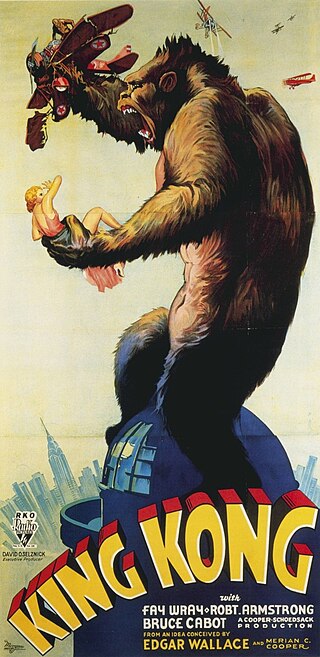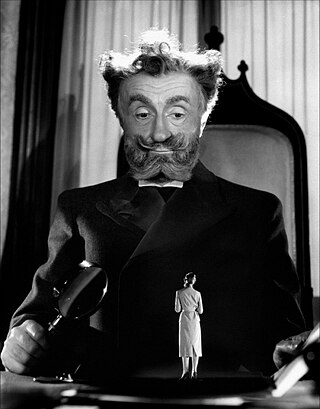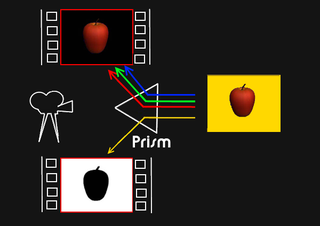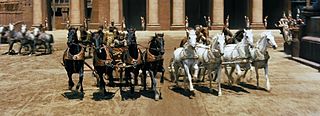
King Kong is a 1933 American pre-Code adventure romance monster film directed and produced by Merian C. Cooper and Ernest B. Schoedsack, with special effects by Willis H. O'Brien and music by Max Steiner. Produced and distributed by RKO Radio Pictures, it is the first film in the King Kong franchise. The film stars Fay Wray, Robert Armstrong, and Bruce Cabot. The film follows a giant ape dubbed Kong who is offered a beautiful young woman as a sacrifice.

Widescreen images are displayed within a set of aspect ratios used in film, television and computer screens. In film, a widescreen film is any film image with a width-to-height aspect ratio greater than 4:3 (1.33:1).

35 mm film is a film gauge used in filmmaking, and the film standard. In motion pictures that record on film, 35 mm is the most commonly used gauge. The name of the gauge is not a direct measurement, and refers to the nominal width of the 35 mm format photographic film, which consists of strips 1.377 ± 0.001 inches (34.976 ± 0.025 mm) wide. The standard image exposure length on 35 mm for movies is four perforations per frame along both edges, which results in 16 frames per foot of film.

Chroma key compositing, or chroma keying, is a visual-effects and post-production technique for compositing (layering) two or more images or video streams together based on colour hues. The technique has been used in many fields to remove a background from the subject of a photo or video – particularly the newscasting, motion picture, and video game industries. A colour range in the foreground footage is made transparent, allowing separately filmed background footage or a static image to be inserted into the scene. The chroma keying technique is commonly used in video production and post-production. This technique is also referred to as colour keying, colour-separation overlay, or by various terms for specific colour-related variants such as green screen or blue screen; chroma keying can be done with backgrounds of any colour that are uniform and distinct, but green and blue backgrounds are more commonly used because they differ most distinctly in hue from any human skin colour. No part of the subject being filmed or photographed may duplicate the colour used as the backing, or the part may be erroneously identified as part of the backing.

Special effects are illusions or visual tricks used in the theatre, film, television, video game, amusement park and simulator industries to simulate the imagined events in a story or virtual world. It is sometimes abbreviated as SFX, but this may also refer to sound effects.

Cinematography is the art of motion picture photography.
Visual effects is the process by which imagery is created or manipulated outside the context of a live-action shot in filmmaking and video production. The integration of live-action footage and other live-action footage or CGI elements to create realistic imagery is called VFX.

Compositing is the process or technique of combining visual elements from separate sources into single images, often to create the illusion that all those elements are parts of the same scene. Live-action shooting for compositing is variously called "chroma key", "blue screen", "green screen" and other names. Today, most compositing is achieved through digital image manipulation. Pre-digital compositing techniques, however, go back as far as the trick films of Georges Méliès in the late 19th century, and some are still in use.

A matte painting is a painted representation of a landscape, set, or distant location that allows filmmakers to create the illusion of an environment that is not present at the filming location. Historically, matte painters and film technicians have used various techniques to combine a matte-painted image with live-action footage (compositing). At its best, depending on the skill levels of the artists and technicians, the effect is seamless and creates environments that would otherwise be impossible or expensive to film. In the scenes, the painting part is static while movements are integrated on it.
In visual effects, match moving is a technique that allows the insertion of 2D elements, other live action elements or CG computer graphics into live-action footage with correct position, scale, orientation, and motion relative to the photographed objects in the shot. It also allows for the removal of live action elements from the live action shot. The term is used loosely to describe several different methods of extracting camera motion information from a motion picture. Also referred to as motion tracking or camera solving, match moving is related to rotoscoping and photogrammetry. Match moving is sometimes confused with motion capture, which records the motion of objects, often human actors, rather than the camera. Typically, motion capture requires special cameras and sensors and a controlled environment. Match moving is also distinct from motion control photography, which uses mechanical hardware to execute multiple identical camera moves. Match moving, by contrast, is typically a software-based technology, applied after the fact to normal footage recorded in uncontrolled environments with an ordinary camera.

Open matte is a filming technique that involves matting out the top and bottom of the film frame in the movie projector for the widescreen theatrical release and then scanning the film without a matte for a full screen home video release. It is roughly equivalent to an uncropped version of the film.

Mattes are used in photography and special effects filmmaking to combine two or more image elements into a single, final image. Usually, mattes are used to combine a foreground image with a background image. In this case, the matte is the background painting. In film and stage, mattes can be physically huge sections of painted canvas, portraying large scenic expanses of landscapes.

A front projection effect is an in-camera visual effects process in film production for combining foreground performance with pre-filmed background footage. In contrast to rear projection, which projects footage onto a screen from behind the performers, front projection projects the pre-filmed material over the performers and onto a highly reflective background surface.

The sodium vapor process is a photochemical film technique for combining actors and background footage. It originated in the British film industry in the late 1950s and was used extensively by Walt Disney Productions in the 1960s and 1970s as an alternative to the more common bluescreen process. Wadsworth E. Pohl is credited with the invention or development of both of these processes, and received an Academy Award in 1965 for the sodium vapor process as used in the film Mary Poppins.

Ultra Panavision 70 and MGM Camera 65 were, from 1957 to 1966, the marketing brands that identified motion pictures photographed with Panavision's anamorphic movie camera lenses on 65 mm film. Ultra Panavision 70 and MGM Camera 65 were shot at 24 frames per second (fps) using anamorphic camera lenses. Ultra Panavision 70 and MGM Camera 65's anamorphic lenses compressed the image 1.25 times, yielding an extremely wide aspect ratio of 2.76:1.

In cinematography, bipacking, or a bipack, is the process of loading two reels of film into a camera, so that they both pass through the camera gate together. It was used both for in-camera effects and as an early subtractive colour process.
Introvision was a variation on a front-projection process that allowed film makers to view a finished composite of live action and plate photography through the camera's viewfinder on set and in real time. During its heyday, starting with the feature film, Outland in 1981, Introvision enjoyed the novelty of visual effect compositing in-camera, thus eliminating the need to wait for photo-chemical compositing to determine if the effect shot was successful.

Multi-image is the now largely obsolete practice and business of using 35mm slides (diapositives) projected by single or multiple slide projectors onto one or more screens in synchronization with an audio voice-over or music track. Multi-image productions are also known as multi-image slide presentations, slide shows and diaporamas and are a specific form of multimedia or audio-visual production.
Foreground and background or background and foreground may refer to:

The Williams process or Williams doublematting process is a matte creation technique patented by the American cinematographer Frank D. Williams in 1918. Unlike prior matte techniques, it allowed for the integration of the actors' movements with previously shot backgrounds.
















